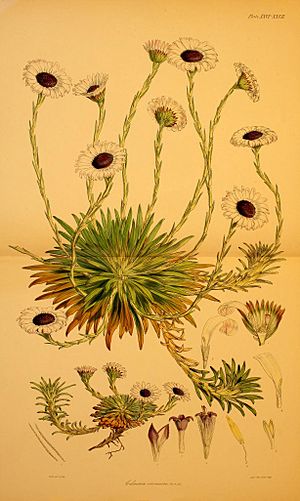Black-eyed daisy facts for kids
Quick facts for kids Black-eyed Daisy |
|
|---|---|
 |
|
| Damnamenia vernicosa as Celmisia vernicosa (Plates XXVI-XXVII Fitch) | |
| Conservation status | |
|
Invalid status (NZ TCS)
|
|
| Scientific classification | |
| Kingdom: | |
| (unranked): | |
| (unranked): | |
| (unranked): | |
| Order: | |
| Family: | |
| Tribe: |
Astereae
|
| Genus: |
Damnamenia
Given
|
| Binomial name | |
| Damnamenia vernicosa (Hook.f.) Given
|
|
| Synonyms | |
|
|
The Black-eyed Daisy (scientific name: Damnamenia vernicosa) is a special type of flowering plant. It belongs to the sunflower family, which includes many well-known flowers like daisies and sunflowers.
This plant is unique because it's the only species in its group, called a genus. It is found only in a few specific places in New Zealand, mainly on the Auckland and Campbell Islands.
Contents
What Does the Black-eyed Daisy Look Like?
The Black-eyed Daisy is a small plant that stays green all year. It's known as a perennial, meaning it lives for many years. It also spreads using special stems called stolons, which grow along the ground and can form new plants.
Its leaves are shiny and green. The flowers look like small white daisies with a dark purple center, which is why it's called the "black-eyed" daisy. You can usually see its flowers from November to January, and its fruits appear from December to March.
Where Does the Black-eyed Daisy Live?
This plant is very special because it is endemic to New Zealand. This means it naturally grows only in New Zealand, specifically on the subantarctic Auckland and Campbell Islands. These islands are located far south of New Zealand's main islands.
The Black-eyed Daisy likes to grow in wet, spongy areas called bogs, especially in high-up places. It also thrives in open fields where other plants like Pleurophyllum grow. You can also find it in windy, open spots at lower elevations where not many other plants can survive.
How Did It Get Its Name?
The Black-eyed Daisy was first described in 1844 by a scientist named Joseph Hooker. He first called it Celmisia vernicosa.
Later, in 2012, another scientist named David Given studied the plant closely. He noticed it was different enough from other Celmisia plants to be put into its own new group, or genus. He named this new genus Damnamenia.
The name Damnamenia comes from a character in old Greek stories, a Dactyl named Damnamenius. The original genus, Celmisia, was named after another Dactyl, Celmis. So, the names are linked!
The second part of its scientific name, vernicosa, is a Latin word meaning "varnished." This refers to the plant's shiny leaves, which look like they have a coat of varnish.
Is the Black-eyed Daisy in Danger?
The Black-eyed Daisy is currently listed as "At Risk - Naturally Uncommon" by the New Zealand Threat Classification System. This means it's not in immediate danger of disappearing, but it's naturally rare because it only grows in a very small area. Protecting its special island homes is important to keep this unique plant safe.

